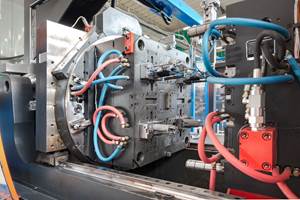Optical Sorting for Color Flexibility in Recycled Plastics
Aaron Industries added optical sorting to its operation, expanding capabilities to meet the color needs of customers.
, a compounder of recycled materials including recycled PS, PP and PE from postindustrial and postconsumer sources, was able to enhance its flexibility and product offerings by implementing an optical sorter.
Aaron serves customers in a wide range of industries, from housewares to agricultural. The company buys recycled granules from outside partners that process plastic waste by grinding, elutriation, sink/float sorting and wash. Aaron pre-blends different regrinds using a proprietary process to hit the customer’s desired mechanical or aesthetic properties.
Recycled materials are often a blend of different colors that end up as a black or gray. For some customers and some applications, that’s not a problem. But for many consumer goods, color is very important. Color can set a brand apart and add shelf appeal, influencing buying decisions. Therefore a supplier of recycled compounds can extract more value from a given material stream by improving color management.
“Customers have always and will always ask for colors — or natural, because they want the flexibility of coloring it whatever they want,” says Todd Marchand, vice president at Aaron Industries.

Plastic granules, before and after undergoing Aaron’s optical sorting process. Source: Aaron Industries.
In response to customer needs, Aaron Industries purchased and implemented an optical sorting machine last year. The new equipment uses a color camera and LED lighting to separate granulated material by color. Recently, Aaron began using the system at full-scale, commercial truckload volumes.
For certain streams, the sorter expands what Aaron can do, turning a mixed stream into a stream that is closer to a particular color, or closer to white or natural. “We’re not matching colors to an actual Pantone,” Marchand explains. “It just opens up the palette for what we can do with that particular stream.”
Each sort brings the material closer to a desired color, not eliminating the other colors entirely but bringing them to a level that makes the resin more usable. The new sorting equipment enables Aaron to produce variations of red, blue, green, yellow, orange, white and even lighter shades.
A recycled stream will not typically be sortable to a pure natural, for example, it can be mostly natural with a hue to it, which can be colored or matched to an application. “It’s tough to sort something to 100%, so a lot of the products we make will have a greenish or bluish hue to them that can be colored over, or won’t matter much if the customer is going to make blue or green anyway,” Marchand says. “But it certainly provides more options to the end user.”
After sorting, sometimes with multiple iterations, materials go on to one of Aaron’s six extrusion lines for blending and pelletization. Finally, postblending assures the customer receives a uniform and consistent product.
The FDA has issued letters of no objection to Aaron for recycling of polyethylene and polystyrene, which enables their use in food contact applications. These materials can also be enhanced by the sorting system, enabling Aaron to work with a customer to offer a compound that includes recycled material in a color that will work for their application.
The company also works with virgin materials, offering mixed content compounds to customers that want to incorporate recycled materials but also need the virgin content for more stable processing and better mechanical properties. Aaron has a minimum batch size for optically sorted material of just 1,000 lbs, with no maximum.
Related Content
Innovative Film Processor Adds Water-Blown Technology to Barrier Offerings
Established as a market leader in technical films in Latin America, Plastilene enters North American barrier market with nine-layer technology, including an upside-down, water-quenched system.
Read MoreFighting Dust and Noise in Regrind Operations
Mayhew Basque Plastics implemented lower speed granulators to deal with challenging materials.
Read MoreMolder Opts for Machine Flexibility for Complex Jobs
AE Plast opted for tiebarless multimaterial Engel victory machines as it took on complex parts for the appliance and power tool market, including a 3K housing for Dremel’s rotary tool.
Read MoreFlexible-Film Processor Optimizes All-PE Food Packaging
Tobe Packaging’s breakthrough was to create its Ecolefin PE multilayer film that could be applied with a specialized barrier coating.
Read MoreRead Next
See Recyclers Close the Loop on Trade Show Production Scrap at NPE2024
A collaboration between show organizer PLASTICS, recycler CPR and size reduction experts WEIMA and Conair recovered and recycled all production scrap at NPE2024.
Read MoreBeyond Prototypes: 8 Ways the Plastics Industry Is Using 3D Printing
Plastics processors are finding applications for 3D printing around the plant and across the supply chain. Here are 8 examples to look for at NPE2024.
Read More











